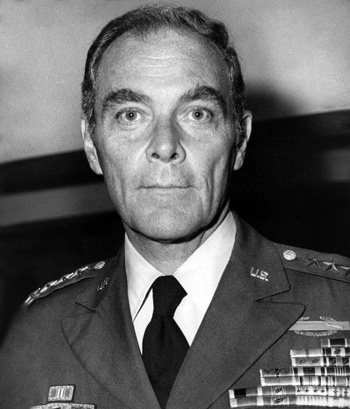
|
Alexander M. Haig, Jr. |
 |
|||
| Rank, Service | ||||
General O-10, U.S. Army |
||||
| Veteran of: | ||||
|
||||
| Tribute: | ||||
Alexander Haig was born on December 2, 1924, in Philadelphia, Pennsylvania. He entered the U.S. Military Academy at West Point on July 1, 1944, and graduated with a commission as a 2d Lt of Cavalry on June 3, 1947. After completing Armored School at Fort Knox, Kentucky, Lt Haig served with the 8th Cavalry Regiment of the 1st Cavalry Division under General MacArthur's Far East Command in Japan from August 1948 to to April 1949, followed by service on General MacArthur's staff at Headquarters Far East Command from April 1949 to September 1950. Capt Haig served as Aide-de-Camp to the commander of X Corps, Gen Edward Almond, in combat in Korea from September 1950 to June 1951, and then Aide-de-Camp at Far East Command Headquarters from June to August 1951. He next served as commander of Company B, 131st Tank Battalion, at Fort Knox from August 1951 to June 1952, and then was training inspector at the Armored School at Fort Knox from June to September 1952. Capt Haig attended the advanced course at the Armored School from September 1952 to June 1953, and then served as an armored tactics instructor at West Point from June 1953 to June 1955. He commanded a Midshipman Company at the U.S. Naval Academy from June 1955 to August 1956, and then served with the 899th Tank Battalion in Europe from August 1956 to December 1957. Maj Haig's next assignment was on the staff of Headquarters U.S. Army Europe from December 1957 to June 1959, followed by Naval War College at Newport, Rhode Island, from June 1959 to January 1960. He then remained on the Faculty at the Naval War College until August 1960. Haig next attended Georgetown University, earning his master's degree in international relations in 1961. He served as a staff officer at Headquarters U.S. Army in the Pentagon from February 1962 to July 1963, and then served as Military Assistant to the Secretary of the Army from July 1963 to February 1964. Col Haig next served as Military Assistant to the Deputy Secretary of Defense from February 1964 to January 1965, followed by service as Military Assistant to the Secretary of Defense from January to June 1965. Col Haig attended Army War College at Carlisle Barracks, Pennsylvania, from June 1965 to June 1966, and then deployed to South Vietnam as G-3 for the 1st Infantry Division in June 1966. He served as commander of the 1st Battalion, 26th Infantry Regiment, from November 1966 to April 1967, and then as commander of 2nd Brigade, 1st Infantry Division, from April to May 1967. He served as commander of the 3rd Regiment of the Corps of Cadets at West Point from May 1967 to June 1968, and then as Deputy Commandant of Cadets until January 1969. Gen Haig then became Military Assistant to the Presidential Assistant for National Security Affairs, Henry Kissinger, serving until April 1971, followed by service as Deputy Assistant to the President for National Security Affairs from April 1971 to January 1973. Gen Haig served as Vice Chief of Staff of the Army from January 1973 until his retirement from the Army on August 1, 1973. During the last few months of service as Vice Chief of Staff of the Army and into retirement, Haig also served as White House Chief of Staff under President Nixon and then Ford from May 1973 to September 1974. He was then recalled to active duty on October 15, 1974, serving as Supreme Allied Commander Europe and Commander in Chief of U.S. European Command from November 1974 until his 2nd retirement from the Army on July 1, 1979. After his retirement, Haig served as President and CEO of United Technologies, Inc., from 1979 to 1981, when he became U.S. Secretary of State under President Reagan. He served as Secretary of State from January 22, 1981, to July 5, 1982, and later ran for the Republican Party nomination for President in 1988. Alexander Haig died on February 20, 2010. |
||||
|
||||

